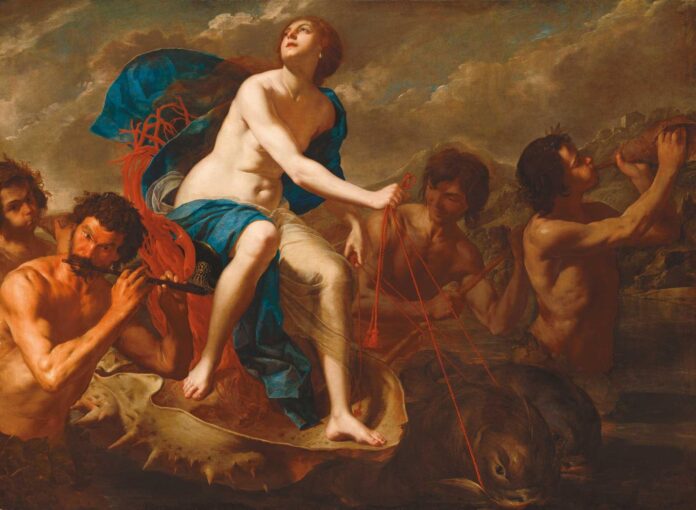The organisers of an exhibition exploring Artemisia Gentileschi’s time in Naples have attributed four works to the 17th-century artist, transforming the art historical canon of arguably Europe’s greatest female Old Master. The exhibition curators, Giuseppe Porzio and Antonio Ernesto Denunzio, have given full attributions to four works on loan from public and private collections in the US and UK, fuelling the ongoing debate around how Gentileschi jointly created works with other key artists working in Naples during her lifetime.
The exhibition at Gallerie d’Italia in Naples, Artemisia Gentileschi in Naples (until 19 March), includes 21 works reflecting the artist’s output in the southern Italian city between 1630 and 1654. It explores the extent of her collaborations with artists such as Bernardo Cavallino, Micco Spadaro (also known as Domenico Gargiulo) and Onofrio Palumbo.
The painting Triumph of Galatea (around 1650) is on loan from the National Gallery of Art (NGA) in Washington, DC. The NGA website states that Cavallino created the work. However, Porzio says that “it is a work by Artemisia created with the extensive participation of Bernardo Cavallino. The caption [in the Naples show] only mentions Artemisia’s name, as we believe that she is the owner of the commission and the creator of the composition”, adding that “in the catalogue entry the question of collaboration between the two artists is clearly spelled out”.
Porzio writes in the catalogue that “a substantial portion of critics, particularly Nicola Spinosa, incline toward the total autography [singular work] of Cavallino”. Porzio adds that another scholar, the late Raymond Ward Bissell, believed that, in terms of “iconography, conception and monumentality, the Galatea from Washington, DC could only have sprung from the mind of Artemisia”.
“This painting has been linked to a commission from Don Antonio Ruffo, an important art collector from Messina, to Artemisia Gentileschi,” the NGA’s website states. The argument in favour of this provenance can be found in Bissell’s publication Artemisia Gentileschi and the Authority of Art: Critical Reading and Catalogue Raisonné (1999), it says.
But the NGA adds that “examination of the work has found no evidence of the separate hands of both Artemisia, to whom the commission was awarded, and Cavallino”. Eve Straussman-Pflanzer, curator of Italian and Spanish paintings at the NGA, says: “We have supported the project from the beginning. I look forward to seeing the exhibition in March and attending the study day where my thinking on Artemisia’s Neapolitan period is sure to be expanded.”
Other re-attribution examples in the exhibition include the painting Susanna and the Elders (1652) from a private London collection, which in the past has also been attributed to Cavallino alone, says Porzio. The work was consigned to auction at Sotheby’s New York in January (estimate of $1.8m to $2.5m) and was attributed to Gentileschi.
Crucially, the Sotheby’s catalogue notes that “Artemisia’s collaboration with fellow painters in Naples during her late career has been the subject of much scholarly debate. In the present lot and its pendant [Bathsheba, in the Columbus Museum of Art, Ohio], Artemisia was responsible for the overall design and conception as well as the primary female nude figures; [Nicola] Spinosa believes all figures are by Artemisia.”
‘Solely under the direction of Artemisia’
The Naples exhibition catalogue also addresses Cavallino’s possible contribution to Susanna and the Elders. Maria Cristina Terzaghi writes that “more problematic is the possible participation of Bernardo Cavallino who could be the author of the two male figures… to try and understand the complexity of the work, it is worth remembering that [Artemisia] addressed the subject of Susanna in other works.”
Meanwhile, two works on loan from the John and Mable Ringling Museum of Art in Sarasota, Florida, Israelites Celebrating the Return of David and Bathsheba at Her Bath (1650s), are listed in the catalogue as by Gentileschi; the US museum classifies the works as “workshop of Artemisia Gentileschi”.
In his catalogue essay, Porzio discusses other possible contributors to Israelites Celebrating the Return of David, saying it is “beyond dispute” that Gargiulo is responsible for the silhouettes in the background and for the roughly hewn landscape, while “there is also the contribution of Palumbo but it is clear that he is solely under the direction of Artemisia”.
The Ringling Museum of Art states online that Bathsheba at Her Bath was likely painted by multiple artists, each specialising in various aspects of the composition. Such collaborative projects were characteristic of Gentileschi’s studio in this period, the museum adds.
Sheila Barker, adjunct professor of art history at the University of Pennsylvania, says: “Two reasons for the difficulty of establishing consensus are the dearth of specific information about the assistants who cycled through Gentileschi’s workshop during her long Naples period, and the stylistic diversity of canvases already in her oeuvre that are associated with those years. New discoveries of documents and the recent additions to her oeuvre have necessitated a fresh consideration of the canvases orbiting around her name and those of her close collaborators.”
• Additional reporting by José da Silva

























